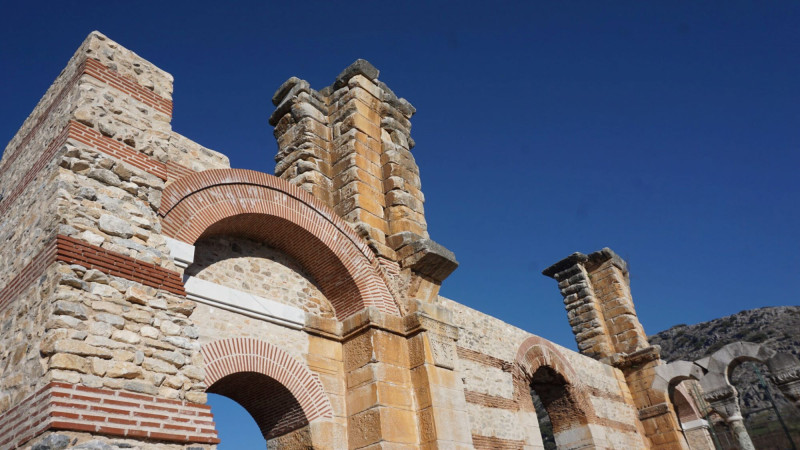The imposing early Christian temple was built in 550 AD. but it was destroyed before the interior decoration was completed, when the central dome collapsed
Basilica II, the imposing early Christian temple located within the archaeological site of Philippi, one of the most magnificent buildings, the ruins of which dominated for centuries the famous city founded by King Philip, has now been restored.
With the interventions made on the ruins of the monument, parts of the building that had been demolished were added and the final result is admirable.
With the completion of the works on the western side of the temple, the visitor can now see what the entrance of the temple was like with the narthex, while to a large extent he realizes the size of the building, its beauty and grandeur.
At the same time, the interventions carried out ensured the stability of the monument from future disasters as parts of the saved building presented problems of deterioration.
For the needs, in fact, of this idiosyncratic restoration, materials were used that are perfectly consistent with the monument so that there is no alteration of its overall image. In this context, marble stones from old Philippi quarries were used.
Technical errors led to the collapse
Basilica II is likely that was built the 550 AD but it was destroyed before the interior beautification work was completed, when the central dome collapsed. This impressive temple after all it never worked.
The study to date leads to the conclusion that the building may was founded onto older and smaller basilica and this created a series of construction errors.
According to scholars, the temple had a brilliant decorationas the capitals, capitals and suffixes, which are excellent examples of decorative art, are among the most important and perfect examples of early Byzantine sculpture and are directly comparable with corresponding members in Hagia Sophia of Istanbul.
Today’s visitor to the ancient city, knowing the history of its construction, can perceive the disappointment and bitterness felt by all its contributors – owners, architect, craftsmen, workers. The failure to build a large and majestic church in the city where the Apostle Paul visited, taught and was imprisoned, here where the first European and Greek woman and Christian, fellow apostle Agia Lydia Philippisia, was baptized, surely filled the inhabitants with sadness.
The performance of the first Divine Liturgy
The first recorded Divine Liturgy, in modern times, was celebrated on Palm Sunday April 22, 1934by the blessed Metropolitan Philippi of Neapolis and Thassos Chrysostomos (later Archbishop of Athens) and there are related photos published in the book “PHILIPPI 1914 – 2014 A CENTENARY OF FRENCH RESEARCH”.
The Divine Liturgy of 1934 was outdoors and was held in the morning at ruins of Vasiliki II with the presence of a large number of people, as evidenced by the photographs of the time.
In modern times, the blessed Metropolitan of Philippi, Neapolis and Thassos, Prokopios, established on the day of the feast of the patron saint of Kavala, Apostolos Pavlos, the outdoor vigil at the ruins of the early Christian church under the light of candles and burning torches. He emphasized that the scattered marbles are “living stones” that keep alive the history of the ancient city of Philippi and the important events that took place there during the presence of the Apostle Paul and also later, when the first Christians of Philippi began to organize the their community and to establish the first Christian church in Greece.
The archaeological site of Philippi, included in the UNESCO World Heritage List since 2006, is now entering a new era both with the restoration of the Second Basilica and with the extensive consolidation projects carried out by the Ephorate of Antiquities of Kavala – Thassos and expected to completely change the image of the famous ancient city of Philippi highlighting its rich and meaningful history.
Source :Skai
I am Frederick Tuttle, who works in 247 News Agency as an author and mostly cover entertainment news. I have worked in this industry for 10 years and have gained a lot of experience. I am a very hard worker and always strive to get the best out of my work. I am also very passionate about my work and always try to keep up with the latest news and trends.














